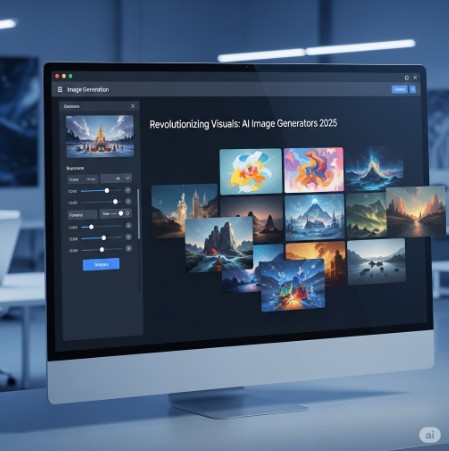The world of image creation is undergoing a dramatic transformation, propelled by the rapid advancements in artificial intelligence. No longer a futuristic fantasy, AI image generation is rapidly becoming a mainstream tool for professionals and hobbyists alike. This exploration delves into the exciting landscape of AI Image Generators 2025, examining the current capabilities, future projections, and potential impacts across diverse industries. We’ll equip you with the knowledge to understand and leverage this technology, regardless of your technical background. This article will address the challenges, opportunities, and ethical considerations surrounding this transformative technology.
Table of Contents
The Current State of AI Image Generation
Current AI image generators utilize sophisticated deep learning models, primarily Generative Adversarial Networks (GANs) and diffusion models, to create stunningly realistic and imaginative images from text prompts or other input data. These models are trained on massive datasets of images and text, learning the intricate relationships between visual features and textual descriptions. Prominent examples include DALL-E 2, Midjourney, Stable Diffusion, and Imagen, each with its own strengths and weaknesses in terms of image quality, style, and control over the generation process.
Understanding Generative Models
- GANs (Generative Adversarial Networks): GANs consist of two neural networks, a generator and a discriminator, competing against each other. The generator creates images, while the discriminator tries to distinguish between real and generated images. This adversarial process pushes the generator to produce increasingly realistic outputs.
- Diffusion Models: These models work by progressively adding noise to an image until it becomes pure noise, and then learning to reverse this process to generate images from noise. This approach often results in higher-quality and more coherent images.
Applications in Various Fields
AI image generators are finding applications across a wide spectrum of industries:
- Marketing and Advertising: Creating compelling visuals for campaigns, website banners, and social media posts.
- Game Development: Generating textures, environments, and character designs.
- Film and Animation: Assisting in concept art, creating backgrounds, and generating special effects.
- Architecture and Design: Visualizing building designs and interior spaces.
- Fashion and Apparel: Designing clothing patterns and generating product images.
AI Image Generators 2025: Predictions and Trends
The next few years promise even more significant advancements in AI image generation. We can expect:
Increased Resolution and Realism
AI models will generate images at even higher resolutions, approaching photorealistic quality. Improved training data and more sophisticated architectures will drive this progress. Expect to see fewer artifacts and more nuanced details in generated images.
Enhanced Control and Customization
Users will gain finer-grained control over the image generation process. This could include more precise control over style, composition, lighting, and other visual aspects. Advanced prompt engineering techniques and more intuitive user interfaces will play a crucial role.
Integration with Other AI Technologies
We’ll see increased integration of AI image generators with other AI technologies, such as natural language processing (NLP) and video generation. This will allow for the creation of dynamic and interactive content that responds to user input in real-time.
Ethical Considerations and Responsible Use
As AI image generation becomes more powerful, it’s crucial to address ethical concerns such as:
- Deepfakes and Misinformation: The potential for creating realistic but fake images that could be used to spread misinformation or harm individuals.
- Copyright and Intellectual Property: The legal implications of using AI-generated images and the ownership of the generated content.
- Bias and Representation: Ensuring that AI models are trained on diverse and representative datasets to avoid perpetuating harmful biases.
AI Image Generators 2025: Addressing the Challenges
Despite the incredible potential, several challenges remain to be addressed:
Computational Resources
Training and running sophisticated AI image generators requires significant computational resources, making it inaccessible to many individuals and organizations. The development of more efficient algorithms and hardware is crucial.
Data Bias and Fairness
AI models can inherit and amplify biases present in their training data, leading to unfair or discriminatory outcomes. Addressing data bias is critical to ensure responsible and ethical use of AI image generators.
Accessibility and User-Friendliness
Making AI image generation tools more accessible and user-friendly for a broader audience requires improvements in user interfaces and the development of more intuitive workflows.
AI Image Generators 2025: The Future is Now
The field of AI Image Generators 2025 is evolving at a rapid pace. The advancements in algorithms, increased computing power, and broader accessibility are poised to revolutionize how we create and interact with visual content. However, responsible development and ethical considerations must remain paramount to ensure that this powerful technology is used for good.
Frequently Asked Questions
Q1: Are AI-generated images copyrighted?
A1: The copyright status of AI-generated images is a complex legal issue that is still evolving. It depends on several factors, including the specific software used, the level of user input, and the applicable copyright laws in your jurisdiction. It’s best to consult with a legal professional for specific advice.
Q2: How much does it cost to use AI image generators?
A2: The cost varies widely depending on the specific platform and its pricing model. Some offer free tiers with limitations, while others operate on subscription-based models or charge per image generated. The cost can also depend on factors such as image resolution and the number of generations.
Q3: What are the limitations of current AI image generators?
A3: Current AI image generators have limitations in terms of controlling fine details, ensuring complete consistency across multiple generations, and handling complex or abstract concepts. They can also struggle with generating images of specific individuals or brands without proper authorization.
Q4: What skills are needed to effectively use AI Image Generators?
A4: While some platforms are designed for ease of use, a basic understanding of prompt engineering (writing effective text prompts) can significantly improve the quality and relevance of generated images. This involves learning about different prompt styles, keywords, and techniques to guide the AI’s output. More advanced users might also explore modifying underlying models and parameters for even greater customization.

Conclusion
The future of visual content creation is inextricably linked to the advancements in AI Image Generators 2025. The technology continues to mature at an unprecedented rate, offering both immense opportunities and significant challenges. By understanding the current capabilities, potential future developments, and ethical considerations, we can harness the power of AI image generation responsibly and effectively. Remember that prompt engineering and a continuous learning approach will be vital to maximizing your success with these powerful tools. Embrace the evolution and explore the creative potential that awaits you in the realm of AI Image Generators 2025. Thank you for reading the DevopsRoles page!
